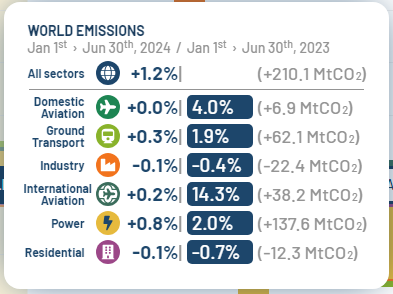-
Posts
5,573 -
Joined
-
Last visited
Content Type
Profiles
Blogs
Forums
American Weather
Media Demo
Store
Gallery
Everything posted by csnavywx
-
Don't think it's a coincidence we started seeing a spike right after NAtl SSTs started surging. Svalbard sits right along a current that incorporates Atlantic water. I strongly suspect we'll see more deleterious effects once that Atlantic water layer shoals into the Arctic.
-
Still some vulnerable ice that can be melted in the Beaufort and ESS. Almost all of this was gone by this point in 2012. CAA and CAB are below 2012 levels at this point (area wise).
-
Carbon Monitor with similar numbers. Aviation starting to become a serious issue. Another year of massive growth.
-
CERES EEI finally flipped significantly negative in May on a monthly basis for the first time since Feb '16. We'll see if it's a blip or not, but EEI trends this year suggest we should finally see some more significant cooling in the next several months (thankfully). 12 mo. rolling average is still around +1W/m2, which is still pretty high considering just how ridiculously hot the last year has been (+1.6C above preindustrial). Kind of sinks the entire 1.5C/2C argument when you're still running positive even after a jump in temps like that.
-
The way August is starting, it has a chance to be a record too. Have to think it finally comes to an end in Sep, though. Last Sep was nuclear.
-
I think this year proves a) how important even a short period of preconditioning in late May-mid June is and b) how with even favorable conditions for most of the melt season, it's getting to the point where even that's not enough. Just repeatedly ingesting these overheated continental airmasses is enough to whittle the remaining pack down.
-
She's still tilted slightly N/NE looking at the radar velocity tilts. Given a westerly shear vector though, that should not take long to fix. Low level center should finish doing a little counterclockwise loop in the next few hours, align and spin up, barring some big dry air ingestion.
-
Out saying that the ice is recovering and it was the highest extent in 20 years, how all "global warmers" were wrong. Exactly the same shit as '16, right before Antarctic sea ice collapsed.
-
I don't want to hear a *peep* about Martz, to be frank. His failed predictions continue to pile up, including sea ice *just this spring*. Always a reliable fade. They always get loudest right before they disappear.
-
Some of the immediate spike is prob due to SSW over the S. Pole recently. I would expect that effect to fade back slowly over the next couple of weeks. Very interested to see how the current marine heatwaves in the NPac and NATL evolve into Sep though.
-
One issue I do see is that the timeseries is a bit shorter than I'd like. What would this method look like in the timespan of something like '97 - '04? One would expect the land sink in '97 to be near zero as well (due to the massive Indonesian peat fires). Seems like the slinky is weighted more towards increasing net respiration in the last two big Ninos over fire events like this, but I'd like to be sure.
-
This goes for you too, @PFizz since you so love to drop in tag people on the issue. Intellectual cowardice and laziness on full display.
-
Back in the real world. Something I've been following closely over the past few years, finally getting some data on recent land sink trends: https://x.com/ciais_philippe/status/1813909550891983318
-
Stop giving him engagement. There is no scenario under which he would consider his hypothesis falsified. He's admitted this. It's now an article of faith by default. Discussing will only make him dig in harder.
-
Land-disrupted TC cores like this are almost always tougher to spin back up in the early stages. Concur with Webb here -- inertial stability is a barrier. Likely going to take until the shear magnitude drops <10 kt and the vector aligns with the track. Last 24 hours before landfall looks very good environmentally, but has a lot of work to do before it can truly take advantage of that. A good signal marker will prob be when that burst pattern starts wrapping upshear.
-
Looks like we're getting that. Lots of surface darkening and blue melt ponds showing up in the past week on Worldview.
-
He can repeat it all he wants. He was wrong about the Saharan dust last year and, imo is wrong to downplay NH shipping aerosols. It's still a point of contention and declaring it doesn't make it so. Much respect to Mike, who helped push the issue into the mainstream in the first place and went a bit out on the limb in the 90s and took an avalanche of unjustified shit for it from deniers. Methinks that's made him more conservative in general. I can't say I blame him given all of the nasty stuff that's happened. But definitely less likely to take risks and make a gutsy call.
-
Got a full break out here and had a gorgeous display. The most visible part was a green curtain/ray/glow but there was faint pink/purple emission over about half the sky. Will post the photos we got here tomorrow. Also got to see a shooting star during the last few photos. Really special night.
-
Also puts nail in coffin for any ECS of ~2 or less. Hell I'd be sweating bullets if my *TCR* estimate was 2 or less at this point.
-
No question 2023 outperformed. Now curious to see how far we re-trace this year and next. A good strong Nina would put it to the test and kind of kill off lingering doubts if there is acceleration.
-
Ya'll are wasting your time. He's already admitted he doesn't have any conditions under which he would change his mind -- so anything you use will simply reinforce the dissonance.
-
Ditto. Feels like I'm already living in South Carolina the last few years. Can't keep my friggin daffodils in the ground past the end of Jan since '21.
-
The same people who top-called Antarctica 8 years ago are now pivoting to top calling the Arctic now. I look forward to your weenie tag tears. Keep short selling that temp graph and keep getting your face ripped off.
-
Looked to me on IR like it got above the tropopause briefly. Total emission just not enough to move the dial very much though. Ironically the bigger movers lately (besides HT WV injection) have been big pyroCB events. The '19/'20 Aus fires esp but the summer Canadian fires last year were no slouch either.







